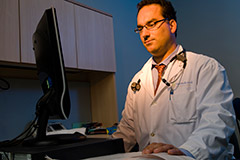CV: Dr. Kaveh Shojania
Bio basics: Patient safety and quality improvement scientist in SRI's combined health services sciences discipline; arrived from Ottawa Health Research Institute in April 2008. Staff internist at Sunnybrook; received MD from the University of Manitoba. Internal medicine residency at Brigham and Women's Hospital (Harvard), and hospital outcomes fellowship at the University of California, San Francisco.
What attracted you to patient safety and quality improvement?
People who get involved in this area typically fall into two groups. One focuses on errors and tries to learn from other high-risk industries like aviation and nuclear power, through really detailed investigations of catastrophic errors. I've done some of that, but my passion is in the other camp, which treats patient safety like any other area of research. It deals with more mundane but still important complications-hospital-acquired infections, adverse drug reactions-and looks for strategies to prevent them. They may not be sexy, but we can apply the traditional biomedical research model: here's a hypothesis that this intervention will prevent these complications; now let's evaluate it.
What's happening in your field currently?
Right now it's a matter of managing expectations. A lot of interventions in patient safety get overhyped, and when we implement them, they don't work as well as we thought. Many people feel we didn't pay enough attention to safety and quality for years-which is true-and that since we're paying attention now, we should be able to make the problem go away. But that doesn't happen, and it's not from lack of effort. Hospitals are complicated places. If you fix one thing in one area, sometimes you create a problem somewhere else. It's about unintended consequences.
Is that the biggest challenge in this area of research?
That's one. The other is ideological. There's a debate playing out right now, which is really a philosophical difference. The question is, should we set the same scientific standards for interventions to improve quality and safety as we do for clinical research? Can we afford to wait for large randomized controlled trials (RCTs) to find out if, say, a computerized order entry system, which we're implementing at Sunnybrook, prevents errors? I'm not saying you always do an RCT, and sometimes you can't test something without implementing it, but hospitals have mandated several costly, complex and time-consuming interventions without good evidence and evaluation.
Is Sunnybrook a good place for this research and evaluation?
It's one reason I moved here. The corporate and academic investment in safety here is really far above what it is most places. We have the patient safety service started by Ed Etchells and Don Redelmeier. The monthly patient safety rounds are very well attended, often with 100 people, and U of T is starting a joint centre for patient safety for which Sunnybrook and SickKids will be the lead sites, so I think Sunnybrook is poised to be a real leader in this area.



